LEARNING FROM XANADU

the Pan-Pacific Auditorium, 7600 Beverly Blvd., Los Angeles,
used as an exterior in the movie Xanadu, burns down in 1989

the Pan-Pacific Auditorium, 7600 Beverly Blvd., Los Angeles,
used as an exterior in the movie Xanadu, burns down in 1989
The [Broadway] show's producer, Robert Ahrens ... felt betrayed by Xanadu [the movie]. "I had an idea of what the film was before I saw it," he says. "I thought it was this mysterious paradise. I thought it would answer a question, I guess, like, 'What is Xanadu?' I thought it was going to be illuminating."
— "Springtime for 'Xanadu' — Can the famously nonsensical disco-movie flop make it on Broadway?" by Michael Martin, New York Magazine (2007) [1]
This intellectual excursion began when I was going through a stack of old DVDs, deciding which ones to keep (the "BELOVED" box), which to watch or rewatch (the shelf above the TV), and which to donate or give away (the "GO" box). I got to a clamshell box still in the shrink-wrap containing the movie Xanadu (1980) [2].
I'm not sure why I originally bought it, for $9.99 about 9 years ago. I saw it in a theater when it first came out, expecting to like it, and found it disappointing. But I couldn't quite remember why it wasn't any good. I decided to watch it one more time, and answer the question: Why did this movie suck?
Sonny: Well I do have one idea, it's kinda stupid.
Kira: Share it with me now.
Sonny: I thought maybe for one moment I could make all the arts converge in one place,
painting, music, dancing, maybe even athletics.
Kira: You mean?
Sonny: Yes, I would like to open a roller disco.
Kira: How timeless.
— Xanadu (2007, Broadway musical), book by Douglas Carter Beane
Those of you who know me know that I find it hard to do things without over-doing them. As fate would have it, once I unwrapped the DVD I found it wouldn't play on any device I owned. I didn't want to rent a digital copy for $3.99 because I would have a 2-day time limit to watch it, and I suspected I was going to have to watch it in short segments to avoid "tuning out." (Eventually a friend advised me over Facebook that I could use Vudu's "Disc to Digital" service [4] to get a digital copy for only two dollars, and that's what I did.) But this delay was ultimately fortuitous, because it sent me into the mountain of free material on YouTube.
As I was processing this material I began talking to random people about it. I asked Esmerelda, proprietress of a local taco shop, if she'd ever seen the movie Xanadu. She didn't remember it. It was before her time. The lady behind me in line (who looked about 20 years younger than me) said "You're old." I explained that I was investigating why it sucked, and she added "You have too much time on your hands." Maybe so, but I've learned to follow my Muse where she leads me. It saves time.
I happened to ask a hostess at a bar if she'd seen the movie, and she said she adored it as a kid, watching the VHS tape over and over, at least 10 times. A male bar patron also had seen it as a kid, but said he didn't remember much except that he was unimpressed. And herein lies the paradox: the people who didn't love this movie don't think it was important, and the minority who think was important do love it. This leaves approximately nobody to explore the question of why it sucked. (YouTube also confirmed that there is a small cadre of rabid superfans of this film.)
And make no mistake about it, the movie did suck. The "Razzie" awards (Golden Raspberries) [5] for each year's worst movies were created in reaction to it. And yet, it had many ingredients of a hit:
The concept was marvelous, but it just didn't come off.
And that's a big part of the problem: this was a big-budget high-concept movie with high expectations. A previous roller disco movie, Skatetown U.S.A. (1979) [9] was lower in overall quality and production values, but ultimately was more entertaining, and didn't get any Razzie nominations.
When I recall seeing Xanadu in a theater 38 years ago, I remember going in with high hopes, but soon becoming bored and fidgety. I wasn't engaging with the story and characters. Once I'd unplugged emotionally, it was easy to notice flaws.
I was talking to a waitress about all this the other day, and she said, "You have something in your teeth." I realized later this is how I felt about the movie. The things it had in its teeth were distracting me.
I approached this conundrum with my typical zeal. I was just coming off a research project on the architects Robert Venturi and Denise Scott Brown, who had helped push us into the postmodern era with their theories, especially in the seminal 1972 book Learning From Las Vegas [10].

close-up of map of Las Vegas strip by Venturi, Scott Brown, et. al.
from Learning From Las Vegas
They and some Yale architecture students took a critical look at the "architecture without architects" found on Las Vegas, Nevada "strip," and in the process analyzed the structure of that space pretty much to death. I realized that if they could intellectualize the vulgar beyond any reasonable limit, then so could I. And I did.
I go to this movie, it's Graumann's Chinese Theater, August 8, 1980, and all over town there were these billboards: "8-8-80." It was supposed to be this big enormous thing, and I found myself sort-of like getting totally caught up, and at some point this thing, like, it just got me — and I just loved it, and everybody was applauding at the end of every number. Going from all my life wanting to be a filmmaker, this very, very stupid movie totally changed the course of my career, something about watching all these dancers sort-of got to me, and then I sort-of said, "okay, I'm going to try my first dance class" and in a year and a half time I became professional and it's just amazing, and I wish it were a more profound film that did that.
— Ken Anderson, professional dancer and fan, quoted in Going Back to Xanadu (featurette, 2008) [11]
I'm going to start with some "atomic" comments, taking a "bottom-up" approach, before I switch to a "global" and "top-down" view.
When I recall seeing the film in a theater on its first run in 1980, I can actually identify the moment when I began to think it was going off the rails. At the 5:55 mark, the nine Greek Muses have magically emerged from a mural in Venice Beach, and the last of them, Terpsichore (nicknamed "Kira"), played by Olivia Newton-John (ONJ), is peeking through her fingers. This is a scene that doesn't work. I find myself thinking that Ms. Newton-John should've asked the director, "What's my motivation in this scene?"
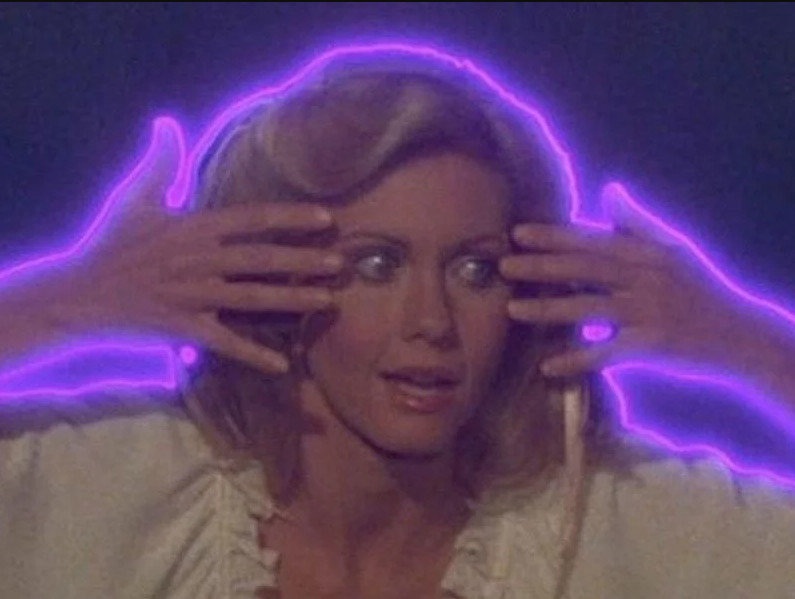
Olivia Newton-John as Greek Muse "Terpsichore"
in the movie Xanadu, peeks through her fingers to
celebrate coming to life out of a mural in Venice Beach,
California in the 20th Century
Actually, it isn't hard to guess what her motivation should have been. Electric Light Orchestra (ELO) is heard singing "I'm Alive" on the soundtrack. The operative emotion should've been joy. What I got instead was the message, "Is this okay? Am I doing it right?"
Upon review I also noticed that ELO was using an electronic distortion technique called a "spectrum follower," a precursor to today's autotune. It makes their singing sound like robots. It occurs to me that they cast ONJ, a top music star, and 8 other beautiful women for the scene (whose characters are never seen again, though the actresses are re-used), and they should be singing the song. After all, they are the ones who have just been magically brought to life.
This followed by some cheesy (but probably very expensive) optical effects, of the Muses turning into Tron light cycles (or something) and flying around the planet doing magical Muse stuff. Kira rocket-skates up to Sonny, the hero, and kisses him, at 8:44, which should have been an awesome moment, except I was still wondering what the frack was going on.
Because of the aforementioned DVD issue, I actually was able to discover and watch footage of the 2007 Broadway musical Xanadu before re-screening the movie. (My first exposure was a clip of the montage the cast performed at the Macy's Thanksgiving Day Parade in 2007 [12], which immediately grabbed my interest.) What I found is that the Broadway show managed to fix just about all of the problems with the movie. So in some of the cases below I had the advantage of seeing things done right, to compare with how they were botched. It feels sort of like cheating, but there it is.
These flubs, none of which are fatal in themselves, increase the distance between the audience and characters, and waste opportunities to build intimacy and affection. The trainwreck continues:
You get this familiar rush of "Oh, I love this song" when you hear the downbeat of it.But no.
She walks in and I'm suddenly a hero
I'm taken in my hopes begin to rise
Look at me can't you tell I'd be so
Thrilled to see the message in your eyes
You make it seem I'm so close to my dream
And then suddenly it's all there
Suddenly the wheels are in motion
And I, I'm ready to sail any ocean
Suddenly I don't need the answers
'Cause I, I'm ready to take all my chances with you
But what we get instead is a nonsensical scene of them skating around a confusing "recording studio" with a fabulous light show and animatronics, while they giggle at each other. The singing is heard on the soundtrack, with ONJ doing a duet with a guy who isn't even in the movie. WTF?
Why do I say
Don't walk away
You'll be the way you were before
When you don't want me anymore
Don't turn around
Don't ever leave
A lonely room where empty days
Are gathering to meet me when you're
Gone, gone...
and so on. Another WTF.
Here is what I concluded:
2. It's kinda-sorta a remake.The 1947 film Down to Earth [17] features Rita Hayworth as a Muse who descends to the realm of humans and falls for a Broadway producer. That's not exactly the plot of Xanadu, but doesn't it sound like a '40s version of the same basic story that Xanadu tells? It should: the latter is a loose remake of the former.
3. But it's actually more complicated than that.
Down to Earth was a follow-up to 1941's Here Comes Mr. Jordan [18], which also dealt with otherworldly beings getting involved with the lives of mortals. (Two actors from Mr. Jordan reprise their roles in Down to Earth.) This original film has been remade twice — once as 1978's Heaven Can Wait, starring Warren Beatty, and again in 2001 as Down to Earth, starring Chris Rock. All of the films are adaptations of the play Heaven Can Wait. So that means that Xanadu is a remake of a sequel to a movie adaptation of a play.
4. And that's not even the end of it.
Xanadu stars Gene Kelly as Danny McGuire, a former big band leader who lost his Muse ages ago. In the 1944 musical Cover Girl, Kelly played a character who works in a nightclub and happens to have the name Danny McGuire. If that weren't connection enough already, Cover Girl has Kelly romancing Rita Hayworth, who played the Muse in Down to Earth that serves as the inspiration for Newton-John's character in Xanadu.
In addition, the movie was originally envisioned by Universal as yet another roller disco ripoff, but then Olivia Newton-John and later Gene Kelley were attached the project and the budget and expectations were bumped up, but neither the creative team nor the schedule were modified.
Basically, it's what happens when you let straight men near the musical.
This is certainly an oversimplification — there are of course many gays who do not have Broadway in their blood, and many straight men who do. But the greater point does apply — there is a culture of musical theater in the U.S.A., and the writers, producers and director of the movie Xanadu were not in touch with it.
Sonny: Dreams die.
Danny: No; no, no, no, not by themselves; we — we kill them.
— Xanadu (1980, movie), screenplay by Richard Christian Danus and Marc Reid Rubel
Produced by a young Joel Silver, the film was directed by Robert Greenwald, whose previous efforts ... had not prepared him to depict the ambitious post-disco universe required. The screenplay, where evident, is a bewildering mash-up of forties swing and eighties proto-punk, mortal and supernatural elements, tap dancing and roller-skating. The last half-hour is basically an opera, indicating surrender in the editing suite; it all ends in a production number involving five mimes, two tightrope walkers, six dozen roller skaters, and Olivia Newton-John gamely singing "Open your eyes and see, What we have made is real" in a medley, wearing a bronze jumpsuit, cowboy regalia, and what appears to be a thin sheen of vegetable oil. She looked beautiful, and sang beautifully, but "the main trouble was the script," says Newton-John, who is performing Xanadu's hits on a tour of Asia. "We had so many story changes during filming.""I blame cocaine," says [Douglas Carter] Beane of the film's glazed messiness. "It's like people say, 'When you hear Ray Charles play, you can hear the heroin'? When you watch Xanadu, you can see the cocaine up on the screen."
— "Springtime for 'Xanadu' — Can the famously nonsensical disco-movie flop make it on Broadway?" by Michael Martin, New York Magazine (2007) [1]
Short answer: I agree with everything said by vlogger "Diva" in her video blog Musical Hell #23 [19].
Long answer: Hollywood draws the distinction between the "above the line" artists who create a movie (producers, writers, director, actors) and the "below the line" craftsmen and women who help them do it. In this case there is plenty of blame to go around for the "above the line" folks, starting at the top.
In TV and the low-budget film world, a director is just a sort of shift-supervisor (like Ed Wood) who keeps things moving during shooting. In "A-list" films the director is often an auteur (like Stanley Kubrick) who is responsible for the original vision and the final result.
So the question becomes: which kind of movie was this supposed to be? Whose job was to keep their eye on the ball? It seems like producers Larry Gordon, Joel Silverman & co. thought that was the director's job — though they did throw him some curve-balls part-way through, like attaching Olivia Newton-John, Gene Kelley and ELO to the project, and upping the budget and the expectations. Director Robert Greenwald talked like he was not in control of the script. In an interview [11] he said when he first saw the script he thought:
I guess they're going to fix it.
and later said,
Well, lo and behold it never got fixed.
Even later he explained,
My solution was to dream up the most interesting magical musical numbers...
I'm reminded of what Danny said about how our dreams don't die, we kill them.
It's worth noting that of all the Razzie nominations the movie received [5]:
the only "winner" was director Robert Greenwald.
But we can spread the blame around some more. Who put Robert Greenwald in? He had previously only directed made-for-TV movies:
Note that none of them was a musical. The story is that he was poached from another roller disco movie, which he apparently never made. This seems like typical Hollywood magical thinking.
The story is also told, by choreographer Kenny Ortega, how Gene Kelley took him "under his wing" and began a mentoring relationship that lasted decades. One thing Gene taught him was you've got to have a raison d'être (reason for existence), both for yourself and what you do. Too bad Gene didn't give that advice to the producers, director and writers.
Handing some blame out to Michael Beck seems easy enough to do, as well as to whoever cast him (his only previous role was in The Warriors, a B-movie fantasy about New York City gangs.) It's a little harder to criticize Olivia Newton-John, though I will admit I have called her Olivia Neutron-Bomb on occasion. She claimed in an interview that part-way through filming she and Gene Kelley knew the movie was going off the rails, but didn't know what to do about it. (How about both threaten to quit? I don't know, just thinking out loud here.)
In Hollywood tradition a "triple threat" can sing, dance and act. I guess this makes ONJ a "double threat."
The movie brought her Hollywood career to a standstill, and then she lived through some tragedies, including marrying a minor actor from the film and then divorcing after they'd had a daughter[20], having a boyfiend fake his own death (without telling her) to escape an ex's alimony (turning up a dozen years later), and getting breast cancer, which she beat and then was inspired to found the Olivia Newton-John Cancer Wellness & Research Centre [21].
(Last summer her cancer returned, and the prognosis is not good.) Meanwhile, possibly because of her life experiences, she evolved as an actress and can do comedy now, as evidenced in the 2011 Aussie movie A Few Best Men [22].
But I have to call it as I see it. ONJ had to sell us the idea that she was an immortal being, thousands of years old. Didn't happen. The first time I saw Kerry Butler playing the Broadway part of Kira (in that Macy's Parade clip [12]) it did happen. She nailed it. And later I saw video of a girl of maybe 17 in a student production at Tom's River High School North on the Jersey Shore, and she also nailed it [23]. So clearly this could be done, but it wasn't done by ONJ.
I've always wanted to do something like Thornton Wilder, where something mystical enters into ordinary life. It took me a while to realize what I was searching for was in Xanadu. It was just so incredibly well disguised by a lack of craft.
— Douglas Carter Beane, quoted in "Springtime for 'Xanadu' — Can the famously nonsensical disco-movie flop make it on Broadway?" by Michael Martin, New York Magazine (2007) [1]
Again I will proceed bottom-up. One of the missed opportunities of the movie was the image in the poster, of ONJ with her hair blowing phantasmagorically.
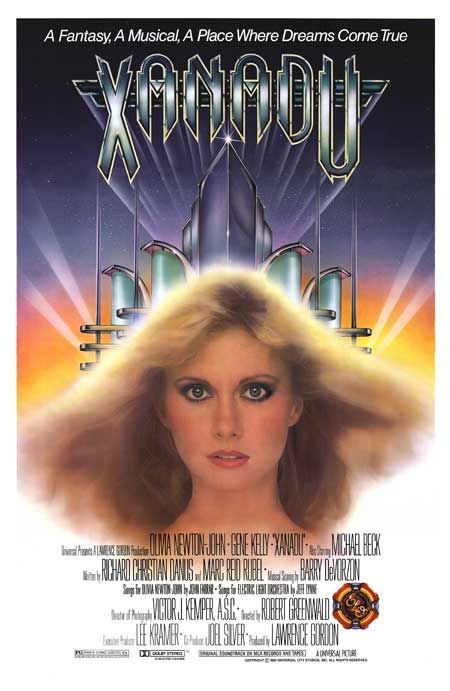
poster for the movie Xanadu showing Olivia Newton-John
with her hair blowing — a scene not in the movie
If you went to see the movie expecting this image, it isn't there. In the Broadway play they deliver on the promise. During the finale, a stage had holds a fan to blow Kira's hair, which gets a big laugh. But it also fulfills an audience craving.
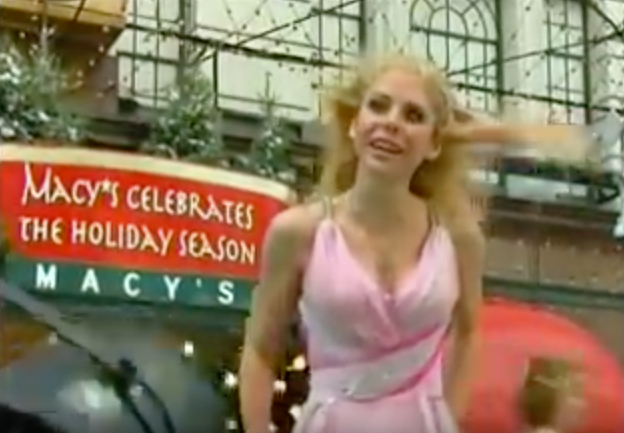
scene from the Broadway play Xanadu, as performed
at the 2007 Macy's Thanksgiving Day Parade, with a stage hand
holding a fan to blow Kerry Butler's hair [12]
Other important changes include:
There are lunatics, adorable lunatics here on Broadway at the Helen Hayes Theater, who have used this movie and the music of the Electric Light Orchestra to inspire a hit, one of the giddiest, silliest, sweetest stage musicals you could ever hope to see. I saw it the other night and I LMAO.
The songs are completely rehabilitated:
Not unlike the stellar job Milos Foreman did when he made a movie out of the Broadway musical Hair [26] the story was adapted to the songs in a wonderful manner. The true hero of this process is Douglas Carter Beane, who wrote "the book" (Broadway slang for the story and all the non-sung dialog).
The play makes a concerted effort to transcend camp and to become post-modern instead. (The rabid fans of the movie defend its campiness, but clearly this was applied after the fact as an apology; it wasn't conceived as camp, like, say, the 1966 TV show Batman.) At the very beginning this ironic position is staked out as Sonny addresses the audience:
Oh hey. I didn't know you guys were here. A whole bunch of you, even like a crowd.But how much do I love when that happens, right? Like when people, regular people, walking along the nice California beach in Venice here, just stop and look at a chalk mural on the wall. For me, like, that's when art is. Just proves that art isn't for the well educated, or the intelligent, but people like you.
In a fit of self-reference (or, as we computer types call it, recursion) the play turns the movie context upside-down: instead of a schlocky and carelessly-made B-movie trying to morph into a big summer hit (like Grease), we are seeing a humble "jukebox musical" [27] morph into a statement about how anything can be art if you do it artfully — even this silly show.
As John Del Signore writes in "It's Official: Xanadu's a Do!" in the magazine "The Gothamist," July 11, 2007 [28]:
The cheap one-liners in Douglas Carter Beane's tongue-in-cheek book do outweigh the funny stuff; be prepared to wince often as the crowd roars at such tired ripostes as ... "Oh, snappeth!" But Beane redeems himself again and again with a shrewd, deconstructive style; one of the biggest laughs of the night comes near the end when Zeus, the central arbiter of taste in the universe, prophecies a nightmarish future in which "creativity shall remain stymied for decades. The theater? They'll just take some stinkeroo movie or some songwriter's catalog, throw it onstage and call it a show."
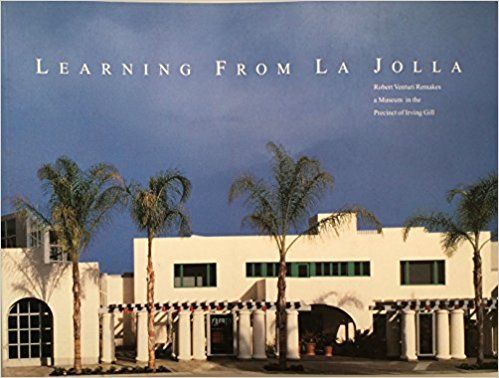
Learning From La Jolla: Robert Venturi Remakes a Museum in the
Precinct of Irving Gill (1998) by Hugh Davies and Anne Farrell
Perhaps it is the fate of all theorists to view the ripples from their works with mixed feelings. I have sometimes felt more comfortable with my critics than with those who have agreed with me. The latter have often misapplied or exaggerated the ideas and methods of this book to the point of parody.
— Robert Venturi (1977) Note to the Second Edition of Complexity and Contradiction in Architecture [29]
I'd like to apologize in advance to Venturi, Scott Brown and Associates (VSBA), whose ideas and methods I have probably misapplied or exaggerated to the point of parody.
The VSBA team is credited with kicking off the post-modern revolution in architecture, even though they've stepped back from that label, preferring to call themselves Mannerists [30] (which is a whole 'nother essay).
In 1996 they accomplished a refurb of the Museum of Contemporary Art, San Diego (MOCASD) in La Jolla, as documented in the book Learning From La Jolla: Robert Venturi Remakes a Museum in the Precinct of Irving Gill (1998) by Hugh Davies and Anne Farrell [31]. I have found a neat correspondence between this project and the productions of Xanadu. I realize I'm running the risk of comparing two things while my readers are familiar with neither, but this is where my Muse is taking me. I must follow. Saves time. Skip ahead if you must.

Ellen Browning Scripps residence, La Jolla,
California, 1915, architect Irving Gill
Here in the San Diego area (where I live) we have come to celebrate a local architect named Irving Gill, who was a very early pioneer of Modern Architecture. Austrian architect Adolf Loos wrote Ornament and Crime in 1913 [32], pretty much kicking off the Modern movement. When asked about his influences, Loos pointed to Irving Gill, acting on his own way out west, who saw the vision before any of them. Gill started with Mission Revival style and scraped away ornament until all that was left were flat-roofed boxes made of white plaster with the occasional arch.
Gill's biggest patron was Ellen Browning Scripps [33], a local philanthropist whose name is all over institutions, buildings and neighborhoods in San Diego County. When a disgruntled, fired gardener burned down her house in La Jolla in 1915, she hired Gill to design the replacement.
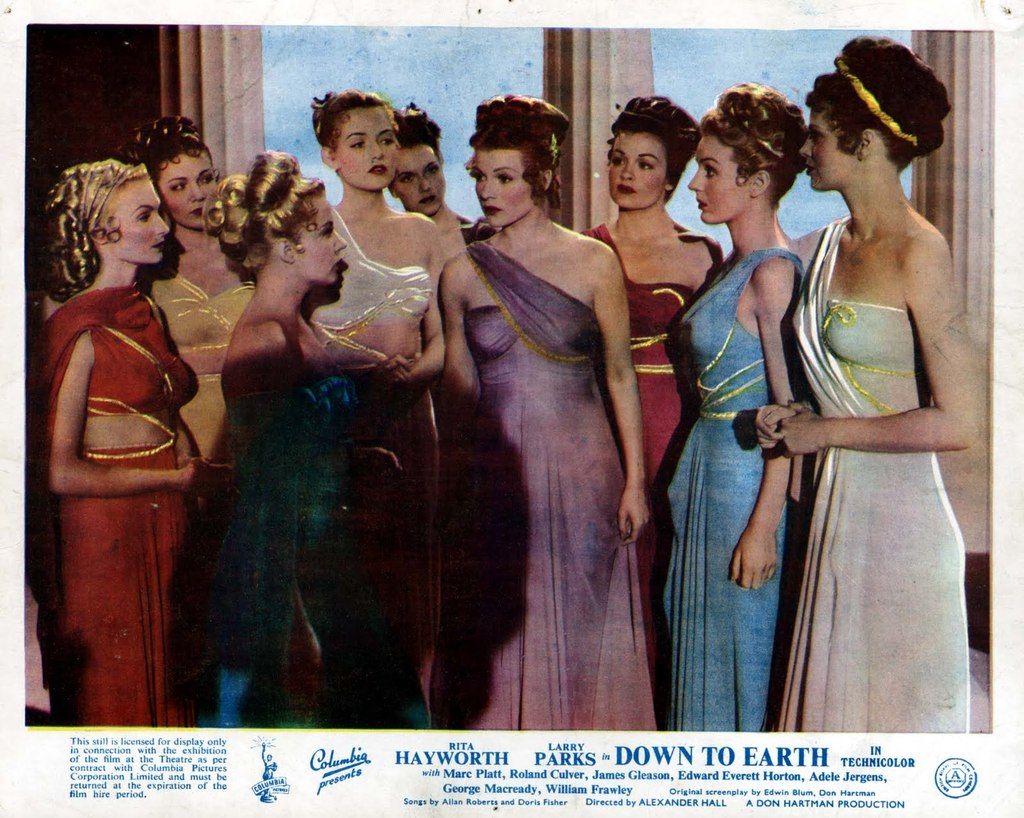
publicity still from Down To Earth (1947) starring Rita Hayworth
This was analogous to the 1947 Rita Hayworth movie, Down to Earth, about the Muses and Broadway, being a thoroughly early-modern movie that reenvisioned a classic theme.

hideous 1951 art museum refurb of the former Scripps
residence, La Jolla, California, 1951
After Ms. Scripps died, she left her house to the community of La Jolla and it became an art center. In 1951 it was refurbed and enlarged to become a boring late-modern building, with none of the Gill features remaining. (History has been so unkind to this development that it is hard to find pictures of it on the internet.)

Venice Beach, California alley set from the movie
Xanadu with Greek Muses mural
This was analogous to the thoroughly late-modern movie Xanadu, Razzies and all. Very little of Greek mythology or the Rita Hayworth film show through.

street front of former Scripps residence — now the
Museum of Contemporary Art, San Diego (MOCASD)
— with restored Irving Gill facade, VSBA, 1996
When VSBA were competing for the commission to refurb the MOCASD, they (and their competitors) were taken on a walking tour of the many Irving Gill structures in the immediate neighborhood. Venturi was the only architect to react with a proposal to bring back the trademark Gill arches on the front of the building, which is probably why his firm won the project.
Seen from the street, the newly-rebuilt museum has many of the charms of the original Gill house, even though it is much larger and has a different purpose.

poster for the Broadway musical Xanadu (2007)
This was analogous to the Broadway play Xanadu, which in its poster reuses the flawed image of Kira peeking through her fingers, as if to show respect for the source material. (Note the tag line, "Seriously." Of course, this too is a joke. Or is it?)

"starline" design in the Axeline Court, MOCASD
But inside the MOCASD building, the first space you enter has this wild ceiling of free-form structure highlighted with neon. It expresses a joy of architecture, but hidden away where it won't upset the neighbors.

disco ball drop for the finale of the Broadway musical Xanadu
This is analogous to the sheer insanity on the inside of the Broadway musical, expressing the joy of the musical genre, and of cheesiness as an artform. As the Muses explain:
Chlio: It is a peculiar thing about these mortals. They all know they will die, yet they are determined to create something. The "human spirit" it is termed. It makes me feel — feel — oh Erato what is the word for which I search? You know, where something is so grand and so earnest yet ultimately so preposterous that one has to laugh. What does one call that?
Erato: Andrew Lloyd Webber?
Chlio: There we are! The human spirit gives me great feelings of Andrew Lloyd Webber.
Sonny: Why do artists always hate their own work before they even finish it?
Kira: Saves time?
— Xanadu (2007, Broadway musical), book by Douglas Carter Beane
The Hollywood movie Xanadu didn't have much of a message; it didn't even rise to the level of "Life is a cabaret." The Broadway musical had a great message: We need Muses not so much to inspire us, but to help us keep pushing when we encounter obstacles, and to overcome doubts. It also promotes the idea that whatever creative activity you are doing, even if it's just to "take some stinkeroo movie or some songwriter's catalog, throw it onstage and call it a show," you should do it as if it mattered — as if the world needs this new creation. (I'd like to think this also applies to silly essays about silly musicals.)
And thereby they spun straw into gold. We need more of this.
After all,
You have to believe we are magic
Don't let your aim ever stray
And if all your hopes survive
Destiny will arrive ...
Less is a bore.
— Robert Venturi, Steven Izenour and Denise Scott-Brown (1972) A Significance for A&P Parking Lots, or Learning From Las Vegas
nymag.com/arts/theater/features/32380
www.amazon.com/exec/obidos/ASIN/B001JV5BEE/hip0bd
www.youtube.com/watch?v=c_-mYomx1nw
www.vudu.com/content/in_home_disc_to_digital.html
en.wikipedia.org/wiki/1st_Golden_Raspberry_Awards
www.amazon.com/exec/obidos/ASIN/B00AEFY5TI/hip0bd
www.amazon.com/exec/obidos/ASIN/B00000AG8R/hip0bd
www.amazon.com/exec/obidos/ASIN/0806505435/hip0bd
www.youtube.com/watch?v=d6QZKeufT_I
www.amazon.com/exec/obidos/ASIN/026272006X/hip0bd
www.youtube.com/watch?v=rrp-4dqHECM
www.youtube.com/watch?v=laBCqiKXsuo
www.amazon.com/exec/obidos/ASIN/9382742611/hip0bd
www.amazon.com/exec/obidos/ASIN/1932907009/hip0bd
www.amazon.com/exec/obidos/ASIN/B005NFJAZS/hip0bd
A HREF="http://people.com/movies/xanadu-35th-anniversary-20-things-you-didnt-know/">people.com/movies/xanadu-35th-anniversary-20-things-you-didnt-know/
www.amazon.com/exec/obidos/ASIN/B0001L3MEO/hip0bd
www.amazon.com/exec/obidos/ASIN/B000KX0IOU/hip0bd
www.youtube.com/watch?v=uWvwEtqAjyY
www.youtube.com/watch?v=WknN7sO2Hc4
www.amazon.com/exec/obidos/ASIN/B00TF7KYCI/hip0bd
www.youtube.com/watch?v=m1So-17qVow
en.wikipedia.org/wiki/Wicked_(musical)
www.youtube.com/watch?v=w02xPH5uUtI
www.amazon.com/exec/obidos/ASIN/0792841638/hip0bd
en.wikipedia.org/wiki/Jukebox_musical
gothamist.com/2007/07/11/its_official_xa.php
www.amazon.com/exec/obidos/ASIN/0870702823/hip0bd
en.wikipedia.org/wiki/Mannerism
www.amazon.com/exec/obidos/ASIN/0934418470/hip0bd
www.amazon.com/exec/obidos/ASIN/1572410469/hip0bd
en.wikipedia.org/wiki/Ellen_Browning_Scripps
www.youtube.com/watch?v=61or9zW27q4
www.youtube.com/watch?v=zNCMLd8TNqA
www.youtube.com/watch?v=uab8VjYruI0
Sonny: I'd like to talk to you about renting one of your spaces. ... It's called the Xanadu and —
Danny: The Xanadu. I haven't thought about that firetrap in years. But what for? You gonna run movies there?
Sonny: Well, yeah. Movies and live theater performances. And there will also be an art gallery.
Danny: Visionary. But I mean in a good way. We developers love the arts.
Sonny: Really?
Danny: Sure, nothing turns a neighborhood around like the arts; then you can kick out the artists and sell it for more to the urban professionals.
— Xanadu (2007, Broadway musical), book by Douglas Carter Beane

diagram by the author of the sequence and timing of songs in Xanadu (movie, 1980) and Xanadu (Broadway play, 2007)
| Xanadu (movie, 1980) {1:36:41} | Xanadu (Broadway musical, 2007) {1:30:48} |
|---|---|
| 1. {4:30} "I'm Alive" (sung by ELO) | 1. {1:24} "I'm Alive" (sung by Muses) |
| 2. {18:06} "Magic" (voice of ONJ and ELO played through loudspeaker) | 2. {9:16} "Magic" (sung by Kira to Sonny while dancing on skates) |
| 3. {26:32 faint, 29:26 see her, 29:54 she sings, 30:46 close-up, 31:10 close-up singing} "Whenever You're Away from Me" (Danny and Kira singing and dancing in the ballroom) | |
| 3. {16:51} "Evil Woman" (sung by Melpomene and Calliope) | |
| 4. {36:48; 39:00 wasted fan; umbrellas} "Suddenly" (on soundtrack; voices of ONJ and Cliff Richard — who is not in the movie; Kira and Sonny skate/dance in "recording studio") | 4. {21:22} "Suddenly" (sung by Kira and Sonny; she on skates, he in a rolling phone booth) |
| 5. {28:09} "Whenever You're Away from Me" (as Sonny leaves Danny's office, Kira arrives, jogging Danny's memories of an old love and dance partner of his, who looked suspiciously like Kira, named Tangerine) | |
| 5. {43:57} "Dancin'" (Danny and Sonny, in the auditorium, imagine differing visions of their ideal club; sung by the 2 bands) | 6. {37:04} "Dancin'" (Danny finds Sonny at Xanadu and shows his vision of '40s big band with Kira; Sonny rebuts as lead singer of '80s rock band; bands fuse) |
| 7. {41:41} "Strange Magic" (sung by Melpomene and Calliope; the evil sisters work their curse, and the winged Eros ... shoots Kira and Sonny with the arrows of love) | |
| 6. {56:11} "Don't Walk Away" (sung by ELO; animated scene) | |
| 7. {1:00:13} "All Over the World" (on the film's music track in the "franchised glitz dealer" store, with Danny running through various dance steps, and some rollerskating, as he tries on different outfits) | 8. {45:46} "All Over the World" (with the help of some of the Muses, Kira and Sonny fix up the old theater) |
| 9. {55:32} "Don't Walk Away" (Clio realizes that she is falling in love with Sonny and tells him that she must leave in a duet with the sisters singing backup; but the evil sisters are not finished; now they offer Danny piles of money if he will tear down the theater and build condos; Danny can't resist) | |
| 10. {1:05:12} "Fool" (Kira reveals all to Sonny, including that her name is Clio, but he does not believe her and is upset; he suggests that she is a crackpot; he also doubts that she really loves him, and she is angry and hurt) | |
| 8. {1:11:51} "The Fall" (on the film's soundtrack, sung by ELO, as Sonny roller-skates toward — and through — the Muse wall painting) | 11. {1:08:06} "The Fall" (Sonny sings after Chlio and her sisters have left; Muses return to dance and sing backup) |
| 9. {1:18:01} "Suspended in Time" (Kira sings on Olympus) | 12. {1:11:42} "Suspended in Time" (Kira sets off for Mount Olympus to receive her punishment from Zeus; Sonny and Danny see her on Pegasus, and Danny convinces Sonny to go after her while he runs to stop the wrecking ball; Sonny and Chlio sing duet) |
| 13. {1:18:23} "Have You Never Been Mellow" (sung by Olympians to Zeus) | |
| ["I'm Free"] | |
| 10. {1:22:10; Kira appears 1:25:34} "Drum Dreams/Xanadu" (sung by Kira and backup singers) | 14. {1:26:32} "Xanadu" (sung by Kira, Muses & chorus; fan blows her hair; Sonny givers her a letterman jacket and they all skate; Danny dances in without skates for musical bridge, as do evil sisters; disco balls drop) |
| 11. {1:28:38} "Fool Country" (ditto) | |
| 12. {1:31:32} "Xanadu" (ditto) |
from Wikipedia article Xanadu (film) — en.wikipedia.org/wiki/Xanadu_(film) (color emphasis added)
from Wikipedia article Xanadu (musical) — en.wikipedia.org/wiki/Xanadu_(musical) (color emphasis added)
last update: Thu Mar 15 19:59:09 PDT 2018